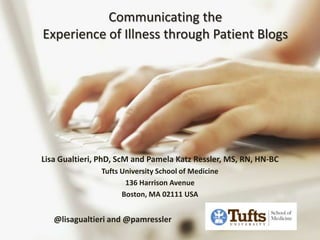
Ressler, P.K. and Gualtieri, L.: Communicating the Experience of Illness through Patient Blogs
- 1. Communicating the Experience of Illness through Patient Blogs Lisa Gualtieri, PhD, ScM and Pamela Katz Ressler, MS, RN, HN-BC Tufts University School of Medicine 136 Harrison Avenue Boston, MA 02111 USA @lisagualtieri and @pamressler
- 2. What is the Problem? Current model of health care delivery does not encourage the patient to communicate the experience of living with chronic illness Lack of research on the phenomenon of illness blogs for patients with various chronic illness diagnoses
- 3. People tell their experience of illness CarePages CaringBridge Gualtieri & Ressler 2010 Technology-enabled
- 4. How Many Patient Bloggers? 13% of e-patients write a blog about their diagnosis and treatment (Pew 2010) e-patients refers to the 61% of US adults who use the Internet for health information Of the 69% of US adults reported having Internet access, 7% reported blogging (HINTS 2007)
- 9. Hard to find: http://garysurgery.blogspot.com/A few are widely read and promoted
- 11. Dana Jennings, New York Times
- 16. Family and friends of patients
- 17. Other people in similar situations
- 20. Theoretical Framework Research is grounded in nursing theory Dr. Margaret Newman’s theory Health as Expanding Consciousness recognizes that health is an awareness or consciousness of the evolving interaction between the individual and his or her environment and is possible regardless of presence or absence of disease. Newman, 2005
- 21. Project Methods Literature search revealed a paucity of information on illness blogs Initiated formative qualitative research in the design of an online survey Developed an online consent to fully inform participants and meet Tufts Medical Center IRB regulations
- 22. Project Methods IRB submitted and approved by Tufts Medical Center A convenience sample of 50 current illness bloggers solicited through through social media forums and online patient communities (n=41) Data analyzed for psychosocial themes as well as demographic data, recognizing that the cohort is a self-selected group of English speaking illness bloggers.
- 25. Demographic data questions (age range, gender, educational level, race/ethnicity) are also asked.
- 27. Has writing a blog made a difference in how you have dealt with your illness? How?
- 28. What motivated you to start a blog?
- 29. Has writing or reading patient blogs changed your sense of connection with others?
- 31. Rare diseases or uncategorized illness
- 32. Cancer, particularly breast and ovarian
- 33. Diabetes
- 36. Caucasian
- 37. Highly educated
- 44. Blogs Shared with Providers? Less than 1 in 4 respondents shared their blogs with their healthcare providers. Reasons: HCP wouldn’t be interested HCP doesn’t have time Want to vent Concerned about judgments or repercussions to care Blog is “my” reality
- 46. Decreased sense of isolation
- 47. Increased ability to tell one’s illness story to others
- 48. Increased accountability (to self and others)
- 49. Increased sense of efficacy
- 52. Would healthcare providers recommend starting a blog and is there an optimal time?
- 53. Are there differences based on type of illness, such as visible/hidden?
- 54. What does someone need to get started?Development of educational tool to assist patients/providers in initiating an illness blog
- 55. And this response says it all… “First I was helped, now I am helping…a reminder that I *am* part of the world.”
- 56. Thank You to Medicine 2.0Questions? @lisagualtieri and @pamressler
Editor's Notes
- Will add caringbrige and carepages
- Lisa Assistive technologies make writing possible for individuals with disabilities and chronic illness
- Lisa continued for short time by family to announce funeral and scholarship fund
- Lisa
- Lisa – a few health sites encourage public or private blogs
- Lisa
- Pam
- Pam